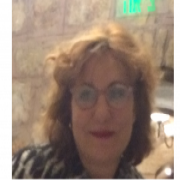Osnat Segal, PhD, is a lecturer at the Department of Communication Disorder, Sackler Faculty of Medicine, at Tel Aviv University. Dr. Segal has earned her BA, MA and Ph.D in Communication Disorders at Tel Aviv University. Her doctoral studies focused on speech perception and language acquisition in infants. During her Ph.D she established the first dedicated laboratory in Israel for assessing processes in speech perception and language acquisition in infants. Her post-doctoral studies focused on recognition of morphological patterns by infants learning Hebrew, and took place at Tel Aviv University and at the Department of Language and Linguistics Science, University of York, respectively. She is the Chair of the Israeli Speech Hearing and Language Association (ISHLA), and a board member of the International Association of Logopedics and Phoniatrics (IALP).
ד"ר אסנת סגל פריידנרייך
ראש חוג בחוג למודי הפרעות בתקשורת

קורות חיים
תחומי מחקר
One of the most interesting questions in the field of language acquisition is how a newborn becomes a speaker of its native language within the short period of the first three years of life. The importance of this question is emphasized by the growing body of evidence suggesting that language-learning disability identified in school-aged children is deep-rooted in the initial processes of language acquisition. Thus, understanding early language-learning processes, from infancy, is highly important in order to: a) gain insight on the typical and atypical courses of language acquisition, b) identify developmental difficulties as early as possible, and c) assess the influence of exposure and use of the native language on the processes of language learning. My goal as a researcher, who is also a communication disorders clinician, is to study the aforementioned processes of early language development in typically developing Hebrew- and Arabic-learning infants as a basis for understanding these processes in special populations including children with autism spectrum disorder (ASD), children with language impairment (LI), children with childhood apraxia of speech (CAS), and children from low socio-economic status (LSES). It should be noted that there is limited data regarding very early language acquisition in infants learning Hebrew and Arabic. Such data is highly important because of the differences in the phonology and morphology between Germanic, Romance and Semitic languages. Thus, one cannot simply generalize data on language acquisition from English or French to Hebrew and Arabic- learning infants.
My research includes three inter-related issues: a) early processes of language acquisition in infants and toddlers, b) the role of prosodic information in language acquisition and its use across the life span, and c) language and speech acquisition in special populations including ASD, LI, CAS and LSES.
פרסומים
Selected Publications
1. Segal, O., Nir-Sagiv, B., Kishon-Rabin, L.,PI & Ravid, D. PI (2009). Prosodic patterns in Hebrew child-directed speech. Journal of Child Language, 36, 629-656.
2. Kishon-Rabin, L., Segal, O., & Algom, D. (2009). Associations and dissociations between psychoacoustic abilities and speech perception in adolescents with severe-to-profound hearing loss. Journal of Speech Language and Hearing Research, 52, 956-972.
3. Kishon-Rabin, L., Harel, T., Hildesheimer, M. & Segal, O. (2010). Listening preference for the native language compared to an unfamiliar language in hearing and hearing-impaired infants following cochlear implantation. Otology & Neurotology, 31, 1275-1280.
4. Segal, O., & Kishon-Rabin, L. (2011). Listening preference to child-directed speech versus non-speech stimuli in hearing and hearing-impaired infants following cochlear implantation. Ear & Hearing, 32, 357-372.
5. Segal, O., & Kishon-Rabin, L. (2012). Evidence for language specific influence on the preference of stress patterns in infants learning a iambic language (Hebrew). Journal of Speech Language and Hearing Research, 55, 1329-1341.
6. Segal, O., Kaplan, D., Patael, S., & Kishon-Rabin, L. (2014). Judging emotions in lexical-prosodic congruent and incongruent speech stimuli in adolescents on the ASD. Folia Phoniatrica et Logopaedica, 66, 25-36.
7. Segal, O., Keren-Portnoy, T., & Vihman, M. (2014). Recognizing Hebrew vocalic patterns in words at 9-11 months. Infancy, 20, 1-29.
8. Segal, O., Heila, S., & Kishon-Rabin, L. (2016). The effect of listening experience on the discrimination of /ba/ and /pa/ in Hebrew and Palestinian ALI. Infant Behavior and Development, 42, 86-99.
9. Segal, O., Houston, D., & Kishon-Rabin, L. (2016). Discrimination of stress-pattern in hearing-impaired infants following cochlear implantation. Ear & Hearing, 37, 225-234.
10. Gold, R.,& Segal, O. Metaphor Comprehension by deaf young adults. Journal of Deaf Studies and Deaf Education (in press).
CHAPTERS IN BOOKS
Kishon-Rabin, L., Taitelbaum-Swead, R. & Segal, O. (2009). Prelexical Infant Scale Evaluation (PRISE): From vocalization to audition in hearing and hearing-impaired infants. In L. Eisenberg (ed.), Clinical management of children with cochlear implants (pp. 325-368). San Diego: Plural Publishing, Inc.
Keren-Portnoy, T. & Segal, O. (2016). Phonological development in Israeli-Hebrew-learning infants and toddlers. In R. A. Berman (ed.), Infants Phonological development in Israeli Hebrew-learning infants and toddlers: Perception and production (pp. 69-94). John Benjamins.

